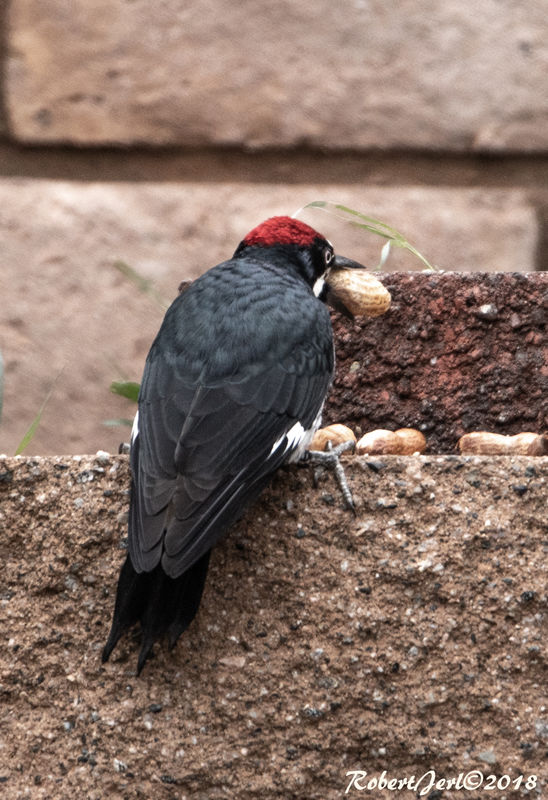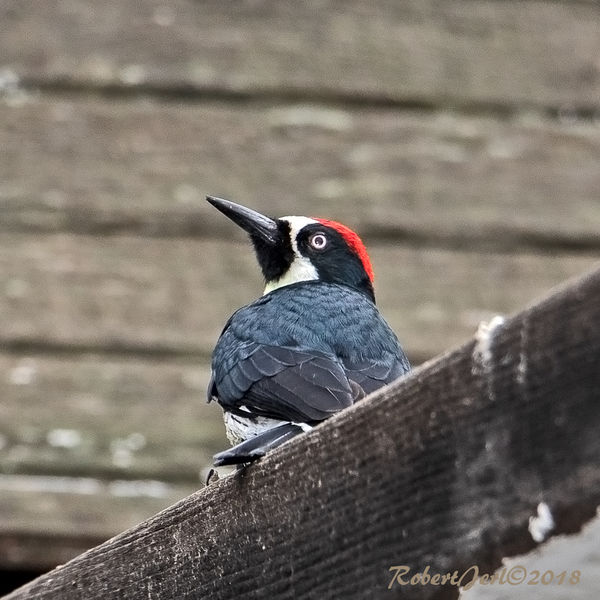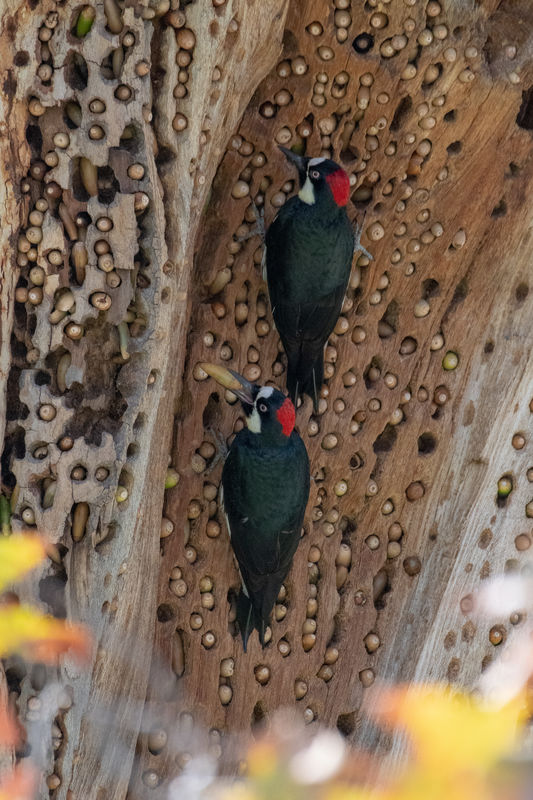Some more of those "long range" close ups of Woodpeckers
Dec 7, 2018 20:09:07 #
In between the rains Wed the Acorn Woodpeckers, crows and jays came after peanuts when I put some out. None of the jays gave me a chance for shots but the woodpeckers did. There were at least 3 or 4 of them coming in relays. Sometimes two or three in view at once. Here is one male getting a peanut off the flowerbed retaining wall and another male waiting on the swing set for his turn.
5DIV, Tamron 150-600 G2 @ 600, 1/200 @ f/6.3, ISO 400 with fill flash using a tripod. Center point assisted AF with spot metering. The bird's black feathers came out a bit under exposed and had to be brought up in processing, extreme crops since these were at aprx 70' and 60'.
Acorn Woodpeckers have a complicated social life. A male will stake out a large territory and attract several females. All the breeding females will lay eggs in a common nest and share the brooding and raising. Then the offspring will stay with the flock, breed themselves sometimes and help raise new generations. They store acorns and other nuts in holes in trees, power poles, wooden buildings etc. "Granary trees" have been found with up to 50,000 holes and from 400 to 500 or more pounds of acorns in one location. Since they are a "flock"/"family" they leave a sentry to guard each cache of food. They will stay all year if food is good, but if they run out before the winter is over they will migrate to a location with better food, even down into Mexico.
5DIV, Tamron 150-600 G2 @ 600, 1/200 @ f/6.3, ISO 400 with fill flash using a tripod. Center point assisted AF with spot metering. The bird's black feathers came out a bit under exposed and had to be brought up in processing, extreme crops since these were at aprx 70' and 60'.
Acorn Woodpeckers have a complicated social life. A male will stake out a large territory and attract several females. All the breeding females will lay eggs in a common nest and share the brooding and raising. Then the offspring will stay with the flock, breed themselves sometimes and help raise new generations. They store acorns and other nuts in holes in trees, power poles, wooden buildings etc. "Granary trees" have been found with up to 50,000 holes and from 400 to 500 or more pounds of acorns in one location. Since they are a "flock"/"family" they leave a sentry to guard each cache of food. They will stay all year if food is good, but if they run out before the winter is over they will migrate to a location with better food, even down into Mexico.
Dec 7, 2018 20:11:02 #
Dec 7, 2018 20:15:56 #
Dec 7, 2018 20:36:14 #
Dec 7, 2018 20:38:12 #
Dec 7, 2018 20:43:51 #
robertjerl wrote:
In between the rains Wed the Acorn Woodpeckers, cr... (show quote)
Robert,
To flesh out your very nice "social history" of the Acorn Woodpecker, I've attached a shot of a pair clinging to a "granary tree" in Irvine Regional Park, Orange, CA. This is just a small part of the "granary" in this one medium sycamore tree. The park contains several such granaries and lots of the woodpeckers. jak
_
Dec 7, 2018 21:07:03 #
jak86094 wrote:
Robert,
To flesh out your very nice "social history" of the Acorn Woodpecker, I've attached a shot of a pair clinging to a "granary tree" in Irvine Regional Park, Orange, CA. This is just a small part of the "granary" in this one medium sycamore tree. The park contains several such granaries and lots of the woodpeckers. jak
_
To flesh out your very nice "social history" of the Acorn Woodpecker, I've attached a shot of a pair clinging to a "granary tree" in Irvine Regional Park, Orange, CA. This is just a small part of the "granary" in this one medium sycamore tree. The park contains several such granaries and lots of the woodpeckers. jak
_
Busy little things aren't they?
I found an article that stated that out on the edge of the desert they found a large saguaro cactus that had over 500 lbs of nuts stored in it. And over in Arizona there was an old wooden water tower/tank that had 485 lbs in it when it was torn down.
Dec 7, 2018 22:28:26 #
I'm not the least surprised. Irvine Regional Park has a mixture of sycamore, fir, oak, and other trees...the perfect place for the Acorn Woodpeckers. Although I can't tell the difference between a male and female of the species, I'm not at all surprised at the family structure...male and harem of females. I'll often see on bird fly to a tree followed over a period of time by several more. Probably members of the family group. (I also saw two pair of Mandarin Ducks the last time I visited this park. They're considered "Exotics" and therefore aren't reported or counted in the RBAs or bird counts...but they're mighty pretty and are relatively rare...glad I got a chance to see them.)
Dec 7, 2018 23:28:49 #
jak86094 wrote:
I'm not the least surprised. Irvine Regional Park... (show quote)
Can't tell the guys from the gals - that I can solve. The males the red cap goes all the way forward and touches the white of the face. The females there is a black bar between the red and white. So your shot has two females.
So. California has a lot of "exotics" thanks to the pet business and people who are either careless or just turn them loose when they become too much trouble.
Dec 7, 2018 23:42:16 #
robertjerl wrote:
Can't tell the guys from the gals - that I can solve. The males the red cap goes all the way forward and touches the white of the face. The females there is a black bar between the red and white. So your shot has two females.
So. California has a lot of "exotics" thanks to the pet business and people who are either careless or just turn them loose when they become too much trouble.
So. California has a lot of "exotics" thanks to the pet business and people who are either careless or just turn them loose when they become too much trouble.
Agreed. Just in this neighborhood and surrounding parks, I've seen several species of feral parrots, Mandarin Ducks, Japanese White Eyes, Scaly-Breasted Munia, Pin-Tailed Waydah, a species of Waxbill, and Egyptian Geese...all of which are releasees or exotics. And thanks for the ID hints for the Acorn Woodpeckers. Now I know. I hadn't really looked in the guides to see if that would tell, but you've saved me the trouble.
jak
Dec 7, 2018 23:58:05 #
Beautiful shots, Jerry, and some very interesting info. I had no idea.
Dec 8, 2018 00:12:36 #
jak86094 wrote:
Agreed. Just in this neighborhood and surrounding parks, I've seen several species of feral parrots, Mandarin Ducks, Japanese White Eyes, Scaly-Breasted Munia, Pin-Tailed Waydah, a species of Waxbill, and Egyptian Geese...all of which are releasees or exotics. And thanks for the ID hints for the Acorn Woodpeckers. Now I know. I hadn't really looked in the guides to see if that would tell, but you've saved me the trouble.
jak
jak
Besides the Nat Geo book and others I like the Cornell University Lab of Ornithology site "All About Birds. https://www.allaboutbirds.org/guide/Acorn_Woodpecker/overview
Dec 8, 2018 00:13:09 #
Dixiegirl wrote:
Beautiful shots, Jerry, and some very interesting info. I had no idea.
Thank you, glad you found it of interest.
Dec 8, 2018 06:06:38 #
robertjerl wrote:
In between the rains Wed the Acorn Woodpeckers, cr... (show quote)
Jerry, excellent pair of photos.


Greg
Dec 8, 2018 14:08:39 #
If you want to reply, then register here. Registration is free and your account is created instantly, so you can post right away.







